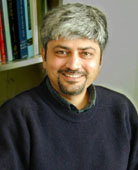 |
Iqbal Ahmad, Ph.D. |
“This opens the tantalizing possibility of treating retinal degeneration from within by activating these adult stem cells,” said Iqbal Ahmad, Ph.D., a researcher and professor in the department of ophthalmology and visual sciences at UNMC and the lead investigator on this study, which was funded with money from the Nebraska Tobacco Settlement Biomedical Research Development Fund.
It is the third new discovery of retinal stem cells from his lab in the last five years.
Several years ago, stem cells were discovered in adult brain. This discovery led Dr. Ahmad and his team to question whether or not there were adult stem cells in the retina, which is a part of the brain, and if so, would these cells be useful in regenerating lost vision.
After extensive research with more than 200 lab rats, Dr. Ahmad and his team got their answer.
Ani Das, Ph.D., a postdoctoral associate and the lead author on the paper observed that one particular type of support cells found throughout the adult retina displayed the cardinal features of neural stem cells — they can self-renew and give rise to all three basic types of cells that make up the human brain. Known as the Muller cells, these adult stem cells also have the potential to generate retinal neurons.
Dr. Ahmad said these same types of Muller cells also are present in the human retina.
“For some reason these cells lay dormant and only become active when the eye is injured,” he said. “The problem is, right now we don’t know how specific injury activates the Muller cells.”
What they do know, Dr. Ahmad said, is that once manipulated into action via a chemical injury in the retina of lab rats some of the activated Muller cells became new photoreceptors and bipolar cells.
All of these cells, he said, are important components that contribute to a person’s vision.
“The significance of this discovery is not only in the potential to manipulate these cells to treat retinal degeneration and restore sight,” he said, “but in the fact that by using your own Muller adult stem cells, problems associated with immune rejection and ethical debate are eliminated.”
Dr. Ahmad said his lab is currently studying signals that allow communication between cells, as the mechanism for the activation of Muller stem cells. This has led to identification of proteins that are found to activate the stem cells.
The next step is to research the efficacy and safety of using these proteins to manipulate these stem cells into action and to see if they regenerate and restore sight.
“We are eager to see if this would occur in humans as well, but it will be several years before we are ready for clinical trials,” Dr. Ahmad said.